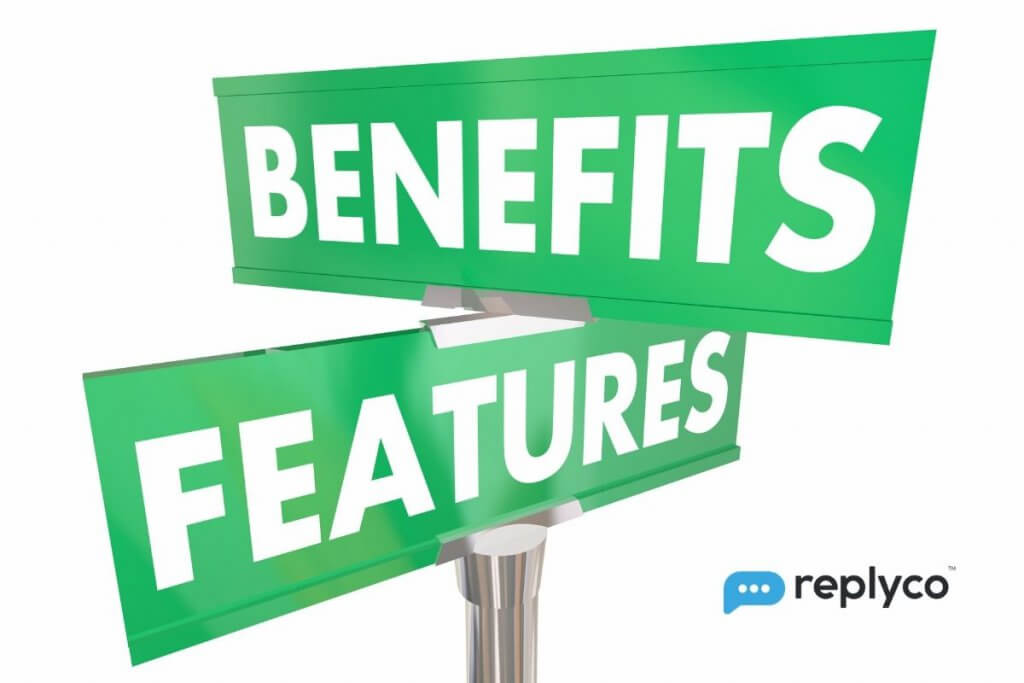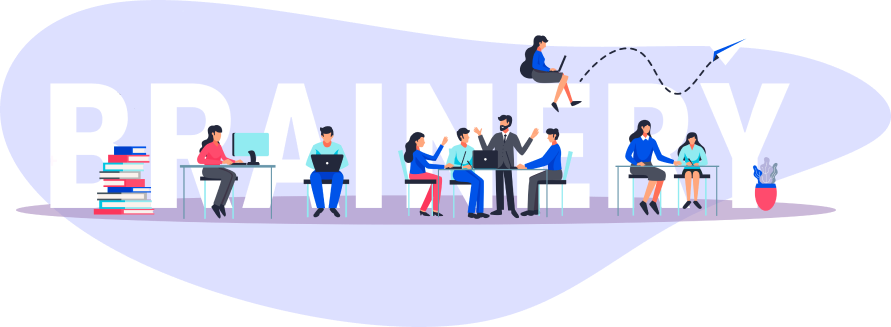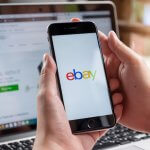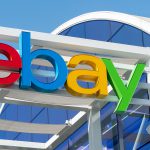Features and Benefits: Your Complete Guide from A–Z

Everything you need to know about the differences between features and benefits, as well as tips for including both in your product descriptions.
If there’s one subject marketers are asked about most often, it’s features and benefits. What’s the difference between the two? And how can I include both in my product descriptions or sales pitches?
That’s because the ability to adequately describe the features and benefits of your products or services is crucial to increasing conversions. Your pitches need to tell customers what you’re selling and why they should buy it.
In fact, that’s a great way to define the difference between features and benefits. Features describe the “what,” while benefits describe the “why.” But as always, there’s a little more to it than that. Let’s take a deeper look at the differences and intricacies of features and benefits, all the way from A to Z.
Features

As stated before, features describe what you’re selling. That means that when you’re laying out the features of your product or service, you’re explaining exactly what it is and what it includes. A through M of your features and benefits ABCs will elaborate further…
About
To begin, think of the features in your product description or sales pitch as your “about section.” This is your chance to tell customers all about your product. What is it? What color is it? How big is it? Provide information about technical specifications, size, the materials it’s made out of, etc.
For instance, if you’re selling a laptop, just a few of the features might include:
- Make / model.
- Processor speed.
- Hard drive.
- Memory.
- Screen size.
- Display type (LED or Retina).
- Keyboard specs.
Put simply, all of the factual information about your item could be considered its features. And once you’ve laid out each and every feature, it will be much easier to explain what the benefits of those attributes are or could be (we’ll have much more on this shortly).
Basics
When brainstorming your product description or sales pitch, it’s a good idea to lay out each and every feature you can think of. Then you’ll be able to see the full picture of what you’re offering and come up with the benefits that convince people to buy. To begin, start with the basics.
What are the most obvious, high-level aspects of your item? Let’s use apparel for this example. Some of the basic features could be:
- Type of apparel (shirt, pants, etc.).
- Color (or available colors if offered in multiple options).
- Sizing options.
- Material (cotton, poly-blend, rayon…).
Characteristics
Once you’ve laid out the basic features of your product, you can also start thinking about its finer characteristics. This is the area where some sellers become confused between features and benefits.
For example, staying on the topic of apparel, characteristics like “soft fabric” ARE features rather than true benefits. While we’ll dive fully into benefits later, let’s explore how this works for a second.
If a shirt’s features include soft fabric, customers can enjoy the benefits of feeling more cozy and comfortable.
Details
Features include every little detail of your product. When putting together all of the “about” information for your wares, dig deep. Define and describe every single aspect of the item.
After all, different customers are looking for different things. Take the clothing example. One shopper might be looking for a soft, all-cotton shirt that’s available in extra-large. Another customer who could buy the exact same shirt might be more interested in the fact that it’s machine washable.
Extras
Your product’s features also include any extras that come with it. Think about the last time you purchased a cell phone. On most websites that sell smartphones, you’ll find a “what’s in the box” section that lists things like charging cable, earbuds, user manual and the like. Those are all features.
Likewise, many eCommerce sellers often offer extra freebies with purchases, such as single-use honey sticks with tea sampler boxes. Be sure to list anything your item comes with in your features.
Facts
A good way to think about features and benefits is that features contain the facts. These are verifiable, specific aspects that accurately describe your product (or service). Again, we’ll discuss this more later, but benefits are often more about feelings, outcomes or results while features are typically more tangible and exact.
For example, “this shirt is 100% cotton” is a feature and an undeniable fact (as long as it is in fact 100% made from cotton). The benefit could be that you will look attractive in it or feel comfortable while wearing it. In other words, benefits are sometimes subjective, while features aren’t.
Guide
Another way to approach describing features is to think of them as giving shoppers a full guide to your product. The features in your product description should tell customers everything they need to know about the item.
By providing a truly comprehensive guide to anything you’re offering, you can help shoppers determine whether it suits their needs and increase the odds that it will sell well.
Here’s an example: Two customers are shopping for travel coffee mugs. Customer A is most concerned with having a mug that fits at least 16 ounces and comes with a secure lid. Customer B wants a coffee mug that is made from ceramic, as she doesn’t like the taste of coffee in metal or plastic containers. However, she also wants a mug that has a lid. If you happen to sell a 16-ounce, ceramic coffee mug with a secure travel lid, providing a well-detailed feature list could help you sell the same mug to both customers.
How Does It Work?
Describing how a product works also falls into the category of features. When trying to understand this principle, just think about automobile specifications. Whether a car has a manual or automatic transmission is a part of its features.
The same goes for battery-operated versus electric items and Android versus Apple operating systems. You get the idea. Make sure to fully describe how a product works in order to help your customers make informed purchase decisions.
Invariable
We’ve already discussed how features cover the facts, but let’s look at this idea in a bit more depth. While benefits may vary based on the customer and what they’re using a product for, an item’s features are generally invariable. That is to say, they don’t change depending on who owns them.
For example, a cotton shirt is a cotton shirt no matter who buys it. However, when selling it to different customers, you might play up different benefits of the shirt’s fabric based on what they’re looking for.
Job
What is your product’s job? In other words, what does it do. An item’s function is also part of its features. Light bulbs illuminate; vacuum cleaners vacuum; coffee makers brew coffee. This may seem like a simple concept, but simple is what features are all about. Remember to accurately and comprehensively describe everything your product does when putting together its features.
Key Attributes
When you’re putting together your list of product details, be sure to focus in on a few of the item’s key attributes. These would be the features that you believe may attract the most buyers, or the ones that best describe the product.
Is there anything particularly special about the item that helps it stand out from competitors’ products? Highlight those features. You might even want to lead with your key attributes in the headline of your product description.
List
When describing the features of your product or service, you don’t want to miss anything. We’ve already said this but it bears repeating: making an exhaustive list of each and every feature of your item will help you immensely when the time comes to determine and describe its benefits.
The best thing you can do is to just sit down and write out (or type out) absolutely every detail you can come up with about your product. You can also categorize or section off your list so it’s easier to go back through later. A few categories could include:
- Basic details.
- Physical characteristics.
- Usage-related features.
- Available options.
- Key attributes.
Measurable
One last consideration if you’re still trying to wrap your mind around what features are is that features are often measurable. This goes back to the fact and invariable sections. Features are quite frequently absolute, tangible characteristics of an item. How big it is, how much it weighs, what types of materials it’s made out of, etc.
Remember, features describe what an item is, in every conceivable way.
Benefits

As stated, features explain what a product is, while benefits convince shoppers of why they should buy it. Put another way, features tell, but benefits sell.
Nuance
Before we really get into how to describe benefits, it’s important to note that the art of writing benefits copy requires a bit of nuance. Every customer has a unique set of wants and needs. Writing product descriptions that convey benefits that attract various types of shoppers takes creativity and style.
Outcome
The simplest way to look at explaining benefits is that benefits tell shoppers what the outcome will be if they buy a certain product. For example, “buy this shirt and you look stylish and feel comfortable.” Or, “purchase this new laptop and enjoy a more stress-free work-from-home environment thanks to faster processing speeds and smooth operation.”
Price-Determinative
Because benefits tell customers about the positive outcomes they can enjoy when buying a product, benefits are much more price-determinative than features. In fact, most sales experts and studies agree that shoppers are more influenced by benefits than features when it comes to how much they’re willing to spend.
For example, the words “ceramic mug” may not mean that much to a shopper, but they might get excited when they read “better tasting coffee.”
Qualitative
When it comes to features and benefits, features are quantitative while benefits are qualitative. In other words, features describe tangible or measurable aspects of a product, while benefits describe their quality.
For example, quantitative (features) = cotton shirt, while qualitative (benefits) = you’ll be cozy and comfortable.
Results
Benefits are ALL about the results. Tell your customers what they will get if they buy your product. In each of the following examples, the benefits are bolded.
“Buy this sidewalk chalk and entertain your children for hours.”
“Create beautiful works of art with this sidewalk chalk.”
“This sidewalk chalk is washable, which makes for easy cleanup.”
Show
We’ve already said that features tell while benefits sell, but benefits also show. They’re all about conveying every way customers will enjoy having or using your product. We see this quite a bit on commercials and infomercials. Think about that non-stick pan we’ve all seen advertised. From melted chocolate to burned cheese, the seller shows us these usually sticky food items sliding right out of the pan with ease. Within just a few quick seconds of seeing the product’s benefits, we know that this pan will be a cinch to use and clean.
Too Good to Pass Up
Benefits are all about letting shoppers know why your product or service is just way too good to pass up. Make sure to describe the benefits in a way that instills a fear of missing out. For instance:
“Get the best sleep of your life on the cloud-like comfort of XYZ mattress.”
Urgency
Along those same lines, you want your benefits copy to convey a sense of urgency. Customers should feel, if this is the right product for them, that they shouldn’t wait another minute to buy it.
We will remain focused on the mattress for this one: “Don’t spend one more night being uncomfortable. Enjoy the cloud-like comfort of XYZ mattress today.”
Variable
While features are invariable, benefits are quite variable. That’s because, as stated before, every customer is different. What one shopper enjoys about a product may differ greatly from what someone else loves about it. That’s why it’s so important to list out every single feature you can think of, so you can then use them to determine all of the various benefits — or wonderful outcomes — the item could lead to.
For example, one customer might buy a jacket in order to look attractive and stylish, while another customer buys the same jacket (with the exact same features) to keep warm or dry. Cover all of the variables in your product descriptions. You may also put up different product descriptions covering different benefits on various channels. That way you can test them to see which ones perform better.
Why to Buy
Again, your benefits copy tells customers why they should buy a specific product. And this is often the easiest way for sellers to create their list of benefits for product descriptions. After coming up with all of your features, make another list of every reason you can think of as to why a shopper might buy the item you’re trying to sell. If we’re talking about the ceramic travel coffee mug, the reasons could be:
- Holds plenty of coffee.
- Fits well into most car cup holders.
- Won’t spill easily thanks to a secure lid.
- Doesn’t interfere with coffee’s flavor thanks to ceramic material.
X-Factor
When you’re writing about your product’s benefits, you really need to find that “X-factor.” Much like the key attributes section earlier for features, this principle has to do with thinking about the benefits that truly make this particular item special.
For example, pretty much all ceramic travel coffee mugs come with a lid and keep coffee tasting great. But is your mug double-walled? In that case, it will likely keep coffee hotter for longer.
You vs. It
When trying to really drill down on the difference between features and benefits, there’s a very simple way to look at them. Think of the features as “it” or “the product” and the customer as “you.” Anything that describes the product is a feature: size, shape, color, materials, specs. While anything that details, “Here’s what you will get out of the product,” is a benefit.
Zero in on ROI
And finally, when defining benefits, zero in on return on investment, or ROI. Tell customers every way that this product will eventually pay for itself. A high-quality computer will save customers time and stress while helping them get more work done. A fuel-efficient car will save shoppers money on gas. A shirt made from the best fabrics, lasting dyes and tight seam stitching will hold its shape and stay true to color for a long time.
Put It All Together
Now that you understand how to fully describe both features and benefits, it’s time to put it all together. After all, the entire purpose of exploring these concepts is to learn how to write product descriptions or create sales pitches that let customers know exactly why they should buy your product or service.
Make sure you lead with the benefits and features you know your customers are looking for. And use features and benefits together in a sensible way. For example, you wouldn’t say, “This coffee mug won’t spill because it’s ceramic.” No. You would say, “This metal-free ceramic coffee mug will keep your coffee tasting great, while the secure lid protects against spills.”
Remain aware of any word limits on the platforms you’re selling on as well and keep things short and sweet, while highlighting the top features and benefits at the beginning, and then elaborating further in the full product description below.
Once you have excellent features and benefits product descriptions in place, you may see a distinct increase in sales. And of course, more sales also mean more questions from customers. To learn more about how Replyco helps eCommerce sellers stay on top of messages and get control of their inbox, take a tour of our features. Or get started today with your free trial!





